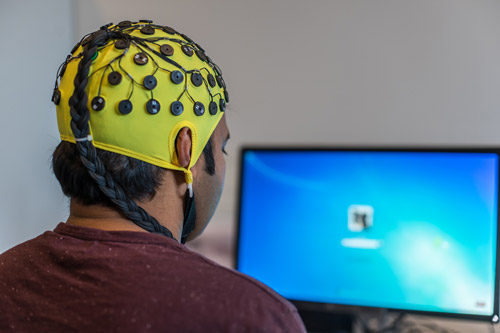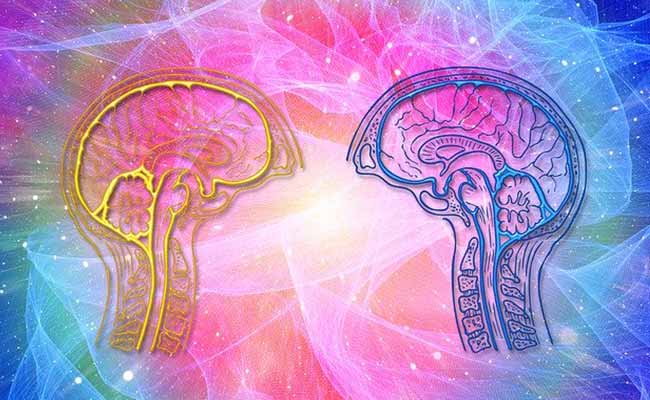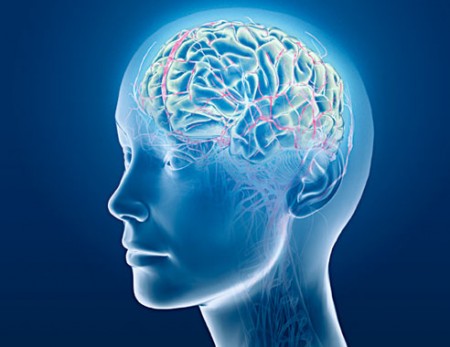Neurofeedback is part of a broader treatment known as biofeedback.
Of course, “neuro” refers to the brain, and that's what we're most concerned with on this blog, but I'm going to cover the whole spectrum so you fully understand what the concept of biofeedback is and how neurofeedback fits in to this form of therapy.
First we'll look at how it works and the different types, then the difference between neurofeedback and brainwave entrainment such as binaural beats, and whether or not the science says neurofeedback really works.

Electrode sensors are attached to the head during neurofeedback.
What is Biofeedback?
Biofeedback is a technique that has evolved with a guiding philosophy that patients should be able to work with their bodies to alleviate symptoms.
The therapy is used to help prevent or treat conditions, including anxiety, migraines, incontinence, chronic pain and high blood pressure.
The practice is — simply enough — people healing through the process of observation of the signals their own bodies emit.
This idea is not totally foreign, nor is it new. The chances are, you’ve experienced or partook in a kind of biofeedback if you’ve ever gotten your temperature recorded or blood pressure tested.
In biofeedback therapy, the idea is exactly the same: instruments are used to record and deliver feedback on the condition of the body. As a result, patients are more equipped to take care of themselves.
Biofeedback’s draw is that by harnessing the power of your mind and becoming aware of what's going on inside your body, you can gain back control over specific health problems.
Different Types of Biofeedback
There are typically three types of biofeedback: Thermal, Electromyography, and Neurofeedback.
In each case, a clinician will record information about the state of the body and the symptoms via a monitor. They will then go through a series of therapies to see how the body reacts, giving a patient a collection of methods that allow them to self-regulate their body’s functioning and help alleviate symptoms
Thermal biofeedback is used to measure skin temperature. This type of therapy can be helpful for those who suffer from disorders like Raynaud’s, which is characterized by a lack of blood-flow to extremities like fingers, toes, noses, and even ears.
Thermal biofeedback has been used to great success for those with Raynaud’s — 80-90 percent of whom report improvements in circulation and decrease in symptoms following the treatment.
Electromyography biofeedback is a technique that helps a clinician evaluate and record the activity of important muscle groups. It is used to assess muscle and nerve cell health and potential degeneration. This technique can be enacted with an instrument called an electromyograph, which will produce a report of the activity, called an electromyogram.
Neurofeedback (also known as EEG biofeedback) is a technique that measures a patient’s brain-wave activity, a useful look into the minds of those suffering from various attention and mental disorders.
What's the Difference Between Biofeedback & Neurofeedback?
To clarify, biofeedback is a general, umbrella term used to describe the overall methodology of utilizing medical instruments to take a measurement of some kind of bodily function that the body cannot measure metrically itself.
Examples include: weighing the body with a scale, measuring blood pressure with a cuff, taking temperature with a thermometer, scanning the brain with a PET scan.
Neurofeedback falls under the umbrella of biofeedback, but refers specifically to biofeedback therapy that is based on brainwave readings (electroencephalograms).
Neurofeedback is used to treat the following:
- addictions
- ADHD
- anxiety
- asthma
- autism and Asperger’s
- bipolar disorder
- cerebral palsy
- chemotherapy side effects
- chronic fatigue syndrome
- chronic pain
- cognitive decline, including dementia
- cognitive enhancement
- depression
- dissociative disorders
- eating disorders
- epilepsy
- fibromyalgia
- headaches, including migraines
- high blood pressure
- insomnia
- learning disabilities
- memory loss
- obsessive compulsive disorder
- Parkinson’s disease
- post-traumatic stress disorder
- restless leg syndrome
- schizophrenia
- stress
- stroke
- tinnitus
- Tourette’s syndrome
- traumatic brain injury
Whether or not you are considering using biofeedback or neurofeedback to improve your health or alleviate specific symptoms, it’s indisputable that the practice of monitoring bodily functions and attempting to give people more power over their own well-being is both a noble cause and a hallmark of a changing medical mindset.
What is Neurofeedback?
Neurofeedback is also known as EEG biofeedback, neurotherapy and brain training. It provides real-time information about your own EEG activity and enables a person to alter his or her own brainwave characteristics by helping the brain to learn to reorganize and by conditioning the brain to function better.
The object of training is to re-educate the brain to make voluntary changes via computerized graphic displays and or auditory signals that challenge the brain to function more effectively.
Neurofeedback therapy can be used to help patients with attention deficit hyperactivity disorder (ADHD), anxiety, depression, seizures and addiction.
Researchers have also found that this type of biofeedback therapy is a great method to reduce pain from migraine headaches.
Others have lauded neurofeedback therapy as a great method of coping for those who are experiencing post-traumatic stress disorder (PTSD) and anxiety, and for those who need cognitive and behavioral therapy or retraining from mental disorders.
What Happens During Neurofeedback Therapy?
You will usually be placed in a quiet space, in a comfortable chair. The doctor will then attach special sensors called electrodes to your head that will feed your brain wave patterns into a computer system.
Typically, you’ll be able to see your brain activity presented in the form of a video game on a monitor.
You will be asked to interpret what you see on the screen. After a while, you’ll learn to control your brain activity to produce a healthy a brain state. So essentially you are playing a video game with your mind. Cool, huh?
The result is that you are harnessing your brain’s ability to change behaviour. This is known as neuroplasticity (modifying your brainwave patterns).
However, different systems operate in different ways though:
For example: There are some methods of neurofeedback that produce the needed frequency to heal your brain — kind of like binaural beats brainwave entrainment — such as the LENS method, the pEMF of Neurofield, and the CES machine (Cranial Electrical Stimulation).
Then there are monitoring devices, such as Emwave that help you to learn to regulate your involuntary nervous system that controls your heart rate.
More recently, a program called NeurOptimal®, developed by Zengar Institute, has presented a new approach . With this system, you listen to music and watch an ever-changing visual display, although you can close your eyes and tune out if you prefer. Kids can even play a game or read a book while sitting down.
NeurOptimal® does not push or pull your brain in any particular direction but instead simply gives the brain information about what it has just done. The brain uses this information to re-organize itself.
The result is said to be a more robust and flexible central nervous system that allows problems to dissipate in a non-invasive way.
When the system detects turbulence in your brain activity, it uses music to gently signal your brain to alter course. In this way, your brain learns to retrain itself to become more effective, calm and balanced.
Different Types of Neurofeedback Therapy
There are numerous neurofeedback systems available at different clinics, and systems for use at home. Here's an explanation of the most common ones:
1. Traditional Neurofeedback:
This is based on operant condition and help retrain the brainwave to optimal level. Methods include Othmer’s low frequency; Paul Swingle Method; Kurt Thornton Gamma Coherence, Nancy White’s alpha/theta training and Robert Thatcher Zscore training.
2. LENS (Low Energy Neurofeedback System):
Developed by Len Ochs, Lens Neurofeedback is a form of biofeedback that works with a person’s brainwaves. It acts like a catalyst that activates the brain’s own capacity for self-regulation and self-healing to restore optimal brain function. It facilitates changes in people of all ages with a wide variety of presenting issues. Addressing the brain in its own electromagnetic language, LENS opens the way for the brain to ‘defragment and reboot’, allowing it to get past frozen, dysfunctional patterns.
3. NeuroField:
This system allows the body to engage its own restorative systems so as to return to a balanced, homeostasis state. It utilizes an ultra-low intensity, pulsed electromagnetic field (pEMF) to replenish energy and reduce stress in the brain and body.
4. pRoshi (Personal Roshi):
The ROSHI differs from standard EEG feedback in that a pair of goggles with lights is used to communicate with the brain directly and disrupt inefficient patterns in the brain. The lights flash at a constantly varying speed, helping the brain to correct dysfunctional patterns and calm the nervous system, reduce spasm and spasticity, relieve pain and reduce inflammation.
5. HEG (Hemoencephalography):
HEG detects changes in the brain's energy consumption. The result is a much simpler feedback signal – it goes up when the brain activates (increases its energy consumption) and down when the brain deactivates (relaxes its energy consumption). It measures the blood flow in the brain and feedbacks to encourage blood flow to the targeted regions. This is known to be effective for migraines and depression.
6. CES (Cranial Electrotherapy Stimulation):
CES produces tiny “microcurrents” that apply a small, pulsed electric current across a person's head with the intention of treating a variety of conditions such as anxiety, depression and insomnia.
7. AVS (Audio/Visual Stimulation):
Through light and sound in coordination together, this type of machine promotes regulation and balancing of the brain/body system.
How Long Does Neurofeedback Last?
A neurofeedback training session typically lasts about 30 minutes.
It doesn't hurt, so don't worry. Most people find it a pleasant and rewarding experience.
The clinician will guide you through the entire process.
What Happens After Neurofeedback?
After a session, a therapist will usually help patients practice relaxation techniques that have been supported by their biofeedback test. These techniques might include: muscle relaxation, breathing exercises, guided imagery and meditation.
Though each clinic may have different advice, depending on the system they use.
How Much Does Neurofeedback Cost?
Neurofeedback is generally charged in sessions, and not usually covered by health insurance. Typically you might pay the following:
Initial Assessment Session (1 hour): £70 / $90
45 minute follow up session: £50 / $65
30 minute follow up session: £35 / $45
Can't I just Use Binaural Beats at Home Instead?
Neurofeedback generally works in a different way to binaural beats. It is more of a “system listens, system feedbacks a correction, brain responds” process, rather than moving the brain into a particular brain state with a concentrated flow of specific frequencies.
There is no brain feedback when listening to binaural beats.
However, systems like CES, LENS or pRoshi do correct the brain in a similar way. They cause a positive change in brainwave patterns by prompting dysfunctional brain patterns to correct themselves and return to a healthy state.
So essentially it shifts you from a negative brain state to a positive one.
Binaural beats have been proven to do just that, and prove particularly helpful for symptoms of anxiety, poor concentration, bad sleep patterns, etc.
Binaural beats are a lot cheaper too, so that would be my first port of call before shedding out for neurofeedback.
✓ Check out the best binaural beats here
What Scientific Evidence is There for Neurofeedback?
– ADHD
ADHD is the most studied condition within the neurofeedback world a meta analysis of 15 studies on ADHD, researchers concluded that neurofeedback effectively reduces the symptoms of inattention, impulsiveness, and hyperactivity.
One review of large-scale clinical trials found that neurofeedback therapy induces a state of relaxed attention, modulates both over and under-arousal, and works comparably to the typical stimulant medications prescribed for ADHD.
However, in a triple blind, randomised study on ADHD patients, recorded in Lancet Psychiatry, researchers compared neurofeedback therapy, ‘fake’ neurofeedback therapy, and CBT (cognitive behavioral therapy).
They found improvements in all three groups. The neurofeedback group was no more significant, leading at least one prominent researcher to proclaim that “although neurofeedback training is effective in reducing ADHD symptoms, it neither outperforms sham neurofeedback nor group psychotherapy. As such, neurofeedback cannot be recommended as an efficient approach in the treatment of adults with ADHD.”
In addition, an August 2016 analysis of 13 randomised trials regarding neurofeedback therapy for children with ADHD came to a similar conclusion, the authors of which stated that “findings from this meta-analysis suggest that neurofeedback cannot currently be recommended as a treatment for children with ADHD.”
– Depression
One study on depression found that the use of neurofeedback decreased depressive symptoms by 50% and, by the end of the study, 5 out of 6 participants were deemed to be “in remission.”
– Performance
One widely reported success story is the Canadian Olympic team. These athletes utilized a variety of biofeedback techniques (including neurofeedback) to sharpen their skills and make them more serious competitors in the 2009 Olympics.
They incorporated the techniques into their “Top Secret – Own The Podium” project, an attempt that was largely successful. Canadians overall placed exceedingly well during the games.
Indeed, studies have found that neurofeedback improves performance by assisting athlete’s concentration and motivation through their competition period.
Further Research
You can find a comprehensive bibliography of neurofeedback studies from the International Society for Neurofeedback & Research here.
In Conclusion
We know that the study of disorders needs to revolve around connections in the brain in order to better understand and alleviate the symptoms a patient is experiencing. And this changing method of approaching disorders explains the surge in popularity of biofeedback and associated therapy techniques such as neurofeedback.
However, research is still evolving, as is technology. And because of that evidence is somewhat inconsistent, with some trials reporting good results and others varied and sometimes none at all.
Where neurofeedback is concerned, it is quite plausible that it might work for some and not for others. Similarly, some people respond very well to brainwave entrainment while others don't benefit much at all.
Science still doesn't fully understand how the brain works and why some people respond to certain treatments and others don't; indeed it is the most complex organ in the body.
There are many therapies we can experiment with that are relatively inexpensive, such as binaural beats, hypnosis, mindfulness practice, yoga and meditation, all of which many people have found work wonders for anxiety, stress, lack of focus, insomnia, pain relief and other conditions where a simple shift in brainwave activity can make a huge difference to our wellbeing.
The important thing is to keep an open mind to possibility and explore and discover what works best for you.



Taylor Bishop says
Thanks for helping me learn more about neurofeedback therapy. I actually had no idea that it could be considered like a category of biofeedback because it refers to biofeedback therapy based on brainwave readings. I’m kind of interested to learn how many other specific techniques there are for biofeedback therapy, even those that are not regularly used.